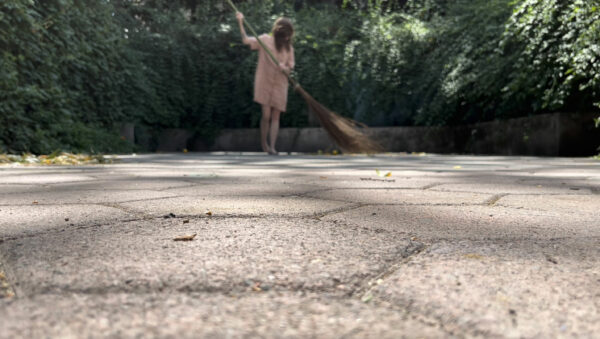Jess Tolbert is a craftsperson and artist based in El Paso, Texas. Her practice reconsiders manufactured, everyday products and materials as wearable and intimate objects. This duality considers how the industrially-made and the handcrafted challenge our nostalgic, imagined, and actual relationships with labor, the built/maintained environment, and identity. Utilizing and inspired by the seemingly commonplace, Tolbert bridges the gap between disparate modes of making in order to consider the role material, process, and people play in the production of things and spaces.
Tolbert received an MFA from the University of Illinois, Urbana-Champaign, and a BFA from Texas State University, San Marcos, both with a focus in Jewelry and Metalsmithing. They are currently an Assistant Professor of Art and Head of the Jewelry + Metals program at University of Texas, El Paso. Tolbert’s work is recognized nationally and internationally and they have been invited/selected to exhibit at the Musée des Arts Décoratifs in Paris, Brooklyn Metal Works, Beijing Design Week, the Houston Center for Contemporary Craft, and New York City Jewelry Week, among others.
Tolbert has also participated in multiple artist residency programs and has been selected for numerous prestigious awards, including the Preziosa Young 2020 award in Florence, Italy, and as a Finalist for the 2020 Loewe Craft Prize. They are a co-founder of the curatorial group Secret Identity Projects, and her work is represented by Gallery Loupe (Montclair, NJ) and Gallery 2052 (Chicago, IL).
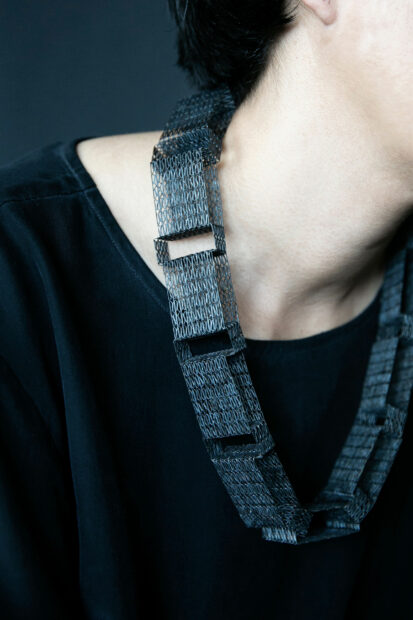
Jess Tolbert, “Greater-Than Series (necklace),” 2019, staples, 22 x 1.2 x 0.6 inches. Photo: Jeanette Nevarez
Nico Silva (NS): I’d love to hear more about how your personal and professional background led you to where you are today.
Jess Tolbert (JT): Some of my first experiences with making and thinking about the body (which are key elements to who I am as an artist) began with learning different types of textile-based craft with my grandmother, like crocheting and sewing my own clothes; it also began with my experience as a dancer, when I was in high school. I think those things helped me understand my interest in process and expression, and have really informed how I make and why I am an artist. I am invested in craft and the bodily experience of objects, which all of craft deals with — especially wearable art, or the things that people use, interact with, or wear. Professionally, I studied jewelry and metalsmithing in undergraduate and graduate school. I was drawn to it because of its connection to the body, but I also enjoyed the meticulous, tedious, and meditative way you work with the materials. Something about those qualities suits my personality.
NS: What inspired you to pursue art in academia? Could you talk about what that has been like at UTEP?
JT: I found a love of teaching as a Teaching Assistant in graduate school. I could see myself pursuing teaching as a career because I felt excited and inspired by the students in the classroom. That has continued in my time at UTEP. Everyday I feel like I am learning from my students just as much as I hope they are from me.
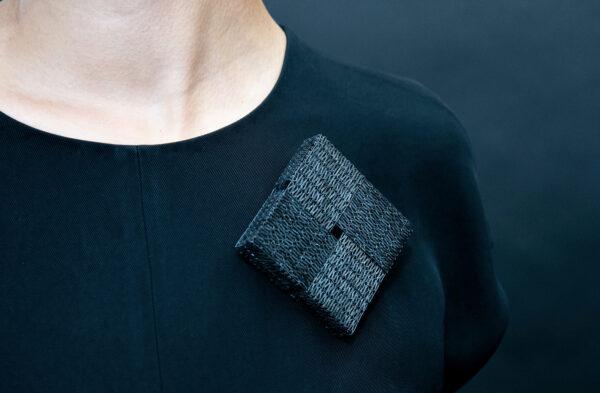
Jess Tolbert, Title: “Greater-Than Series (brooch),” 2019, staples, steel, 14K gold, 4 x 4 x 0.75 inches. Photo: Jeanette Nevarez
NS: Please tell us about your past and current students that you feel have made an impact.
JT: Cassandra Adame was the first UTEP recipient of the prestigious Windgate-Lamar Fellowship, which is awarded to only ten undergraduate students a year who show “exemplary skill in craft.” Since graduating, she has founded Cantareras, a community-based educational business for ceramics and jewelry.
Sandra Salaices has built her own successful contemporary jewelry brand. She exhibits and sells her work throughout the U.S. and Mexico, teaches workshops at craft schools in both countries, and completed a one-year artist residency at the Southwest School of Art in San Antonio in 2019.
Sandra and Cassandra are also two founders of Colectiva Tilde, one of the few Latin American contemporary jewelry collectives. They were recently featured in Metalsmith magazine.
NS: What has been inspiring your work and practice lately?
JT: Brooms. Neon yellow. Scaffolding. And the sound of labor.
NS: I recently saw you at the Texas Association of Schools of Art (TASA) Conference, which took place in El Paso in October 2022. How was it for you and do you have any key takeaways?
JT: It was actually my first time attending, because I was selected as this year’s “Paul Hanna Speaker,” which is awarded to a visual artist to present on their work. Every time I do an artist talk it’s a bit nerve-racking, because I don’t see the artist talk as something separate from my studio practice — yet it is SO much more public. I’ve always admired artists who weave the story of their work with images and nuance, allowing you to feel like you get to peek inside their brain for a moment — so I strive to do the same, especially thinking about it in terms of narrative. I use talks as an opportunity to reflect and expand my thinking about my practice. It’s like any good deadline, but with a live audience. This particular talk was the first I did after an artist residency in Mexico, so it came at the perfect time for me to put the experience into words.
Overall, TASA did a great job in programming, with topics touching on relevant and critical concerns in academia today. It was very inspiring and connected me to a diverse group of academic arts professionals in the state.
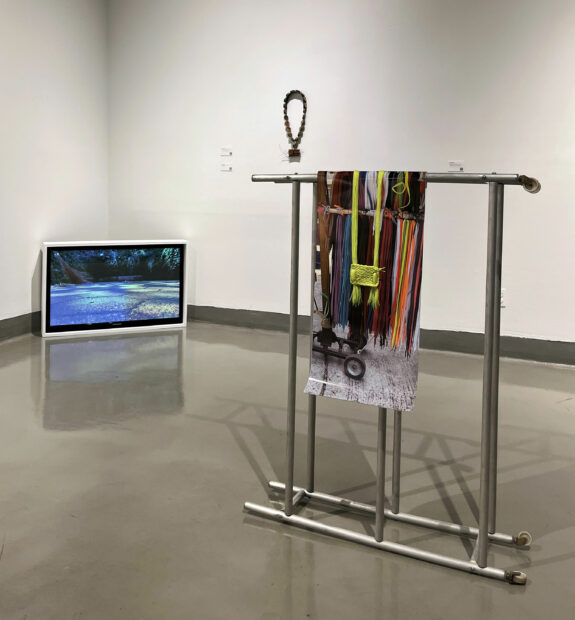
Installation view of the 2023 UTEP Faculty Biennial, “Study is what you do with other people,” at the Stanlee & Gerald Rubin Center for the Visual Arts,
2023. Photo: Jess Tolbert.
NS: The UTEP faculty art biennial Study is what you do with other people at the Stanlee and Gerald Rubin Center for the Visual Arts opened on January 19, 2023 and closes Friday, April 7, 2023. Will you tell us about your pieces and what you hope audience members take away from the exhibition?
JT: I will have two necklaces and one video on view, which were made during a recent artist residency at Casa Lü in Mexico City. They are about seen and unseen labor, everyday or mundane tasks, and identity. These are continuous threads in my work, but in these new works I feel I’m honing in on the ideas more clearly. I hope through material and process my work can speak to things we don’t normally consider, or simply things that we pass by. The pieces utilize new-to-me materials, from shoelaces to escobas to video, so I am excited to exhibit them — this is only their second time being seen. I hope readers will make a trek west to come see!
NS: What have you been reading, seeing, and consuming lately? (Media, food, beverages, etc)
JT: Well, I’m a bit out of my normal routine since we’re talking during winter break, between semesters. I have been doing some traveling to see family and friends, taking time to rest, and I actually went on vacation! Not a work “vacation,” where something I’m doing creatively happens to be in an interesting place, but a real vacation. So most recently I’ve been seeing and consuming all things Paris — the city’s insane museums, pastries, and delicious wine. It really is as magical as people say!
In my normal, not Parisian life, if any interesting bands are coming through El Paso I like to go to shows; I’ve been reading the beautiful poetry of Ocean Vuong; and I’m always listening to the podcast Ologies with Alie Ward. I would consume guayaba (guava) jam everyday — if I could find it.
NS: When you were in art school, who were your heroes and role models?
JT: My undergrad mentor Beverly Penn was and continues to be both a hero and role model. Bev introduced me to metalsmithing in such an expansive way. I think this is why I connected so deeply with it. I never felt I had to do it one way; she left the door of possibility open. She is an incredible thinker, cheerleader, and artist. I still want to be like her when I grow up. An artist that inspired me in school and still does to this day is Dario Robleto. His research is incredibly deep and important, and the translation of that through material is awe-inspiring. I’m fascinated by the craft that goes into each work, and the thoughtful details that connect the objects made to the ideas and inspirations behind them — both poetically and tangibly. I could go on and on, Dario is amazing.

Jess Tolbert, “Aguejetas (Ceci)”, agujetas (shoelaces) purchased in CDMX, brass grommets, printed photograph of shoelace cart, 2022, 28 inches long, pendant: 3.375 x 2 inches, print: 13 x 32 inches. Photo: Rubén Garay
NS: Can you talk about the power of artist residencies and give us some fun facts or stories from your time at Casa Lü?
JT: The power is in time. Time to think about your own practice uninterrupted. I loved feeling like a student again, because the residency at Casa Lü in Mexico City provided weekly meetings with a curator to talk about your work and give feedback. My work took new directions, including in materials and methods like writing, photography, video, and experiments with installation.
A big part of doing the residency there was not only having time for my practice, but being able to immerse myself in the culture of Mexico City. The residency was six weeks, but I stayed for three months. I signed up for weekly Spanish lessons; I wandered the streets paying attention to all the differences in architecture, objects, and whatever interesting things I discovered along the way; I ate and drank delicious things regularly; and I made great friends. It was a dream! It is also where my love of guayaba (guava) began.

Jess Tolbert, installation as part of “Desire Path” at Casa Lü Residency Mexico City. Photo: Rubén Garay
NS: Do you have any advice for emerging and established metals and jewelry artists?
JT: Apply for exhibitions, residencies, fellowships — everything. Get your work out there and seen by the field and beyond. Most of my opportunities and networks have come from doing that persistently.
NS: I have been thinking about the power of non-traditional art exhibiting and curating for a while. I know you are co-founder of Secret Identity Projects (SIP) — could you tell us more about that?
JT: I co-founded SIP with my colleague and friend Kerianne Quick, an artist and Associate Professor of Art at San Diego State University. We have primarily done contemporary jewelry exhibitions in incredibly non-traditional spaces, including briefcases carried through the streets of New York City, the back of a U-Haul truck, and even a mobile storytelling Cash Cab-like jewelry experience. We are interested in finding new and exciting ways to exhibit wearable art, which can be a challenge when a key element, the body, is not present. We are good collaborators and have a lot of fun doing it, so it comes quite naturally to us. We tend to take our time developing the ideas, usually working with tiny budgets, so the outcome is professional-make-do with a lot of passion.
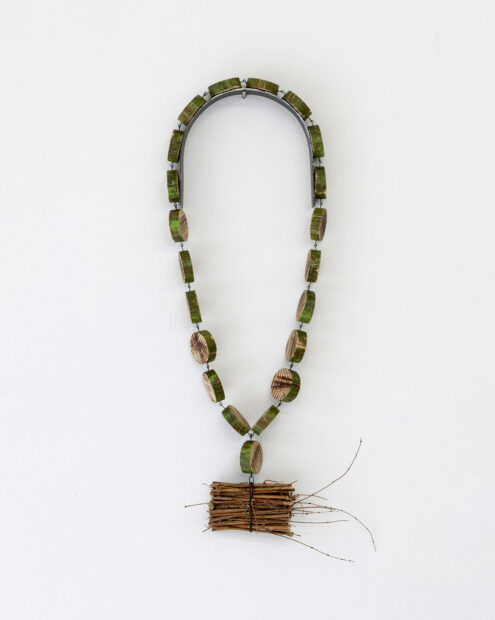
Jess Tolbert, “Escoba (Timateo y Gloria),” 2022, escoba (broom) purchased in CDMX, steel wire, 28 inches long, pendant: 3.375 x 2 inches. Photo: Rubén Garay
NS: You have been in the El Paso area for seven-and-a-half years now. What are some of your favorite things about border life and culture?
JT: Exactly that. Living at the convergence of place and people is incredibly dynamic. It’s like no other place I have lived, and I have lived in many places. I was born in Colorado, but before I could form memories my family moved — from the west to the east coast, and in between. I’ve lived in eight states and almost double the amount of cities. I’m not from a military family, just a nomadic one, and I think my unrooted-ness is something that makes me feel at home here. El Paso is a place where most people are born, raised, and stay — literally, the opposite of my experience, and there is something comforting in that. Also, the burritos are the best.
NS: If you had to host friends for a weekend who had never been in El Paso, what would you do?
JT: I do this often because I am always trying to get my friends from out of town to come visit. First, I would tell them to bring their passport so we can cross to Juárez, Mexico. Go out to dinner at Elemi. Go hiking in the Franklin Mountains. Nachos and beer at The Tap. Go see the current exhibitions at the Rubin Center. Eat some burritos.
Jess Tolbert can be followed on instagram at @jessietolb.
Tolbert’s recent exhibitions include: the 43rd Annual Contemporary Crafts Exhibition at Mesa Contemporary Arts Museum, Desire Path at Casa Lü in Mexico City, MX, Small Acts: The Craft of Subversion at the City Gallery of San Diego City College, and Biennial 600: Justice, Equality, Race, Identity at the Amarillo Museum of Art.
Tolbert has an upcoming solo exhibition, curated by Charlene Lachicotte and running from October 23 – November 16, 2023, at Joan Derryberry Art Gallery at Tennessee Tech University in Cookeville, TN.
Nico Silva is a writer, scientist, social worker, and academic. He envisions a world where art and artists are supported to their highest potential.


